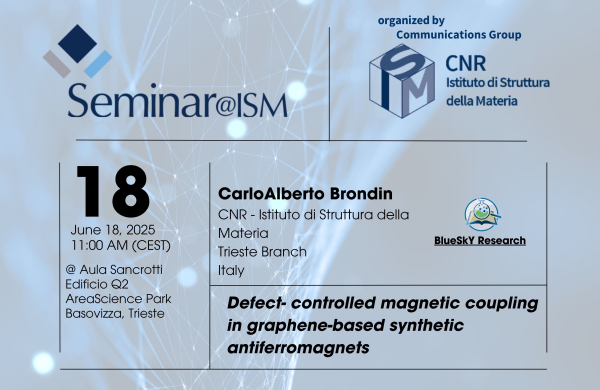Synthetic antiferromagnets (SAF) with compensated stray magnetic fields offer ideal features for driving topological magnetic structures, skyrmions in particular. Rare-earth free SAFs with perpendicular magnetic anisotropy can be readily fabricated by interposing a graphene spacer between ultrathin 3d transition metals. The prototypical system Fe/graphene/Co hides a surprising level of complexity when considering real interfaces. In our study, we experimentally and theoretically demonstrate the sensitive dependence of magnetic properties on the structural integrity of the graphene spacer.
Spectromicroscopy experiments with chemical, structural and magnetic sensitivity reveal the role of graphene defects in the Fe-Co magnetic coupling. The overall sign and magnitude of the Fe overlayer magnetization can be controlled by passivating graphene defects using nonmagnetic atoms and molecules. Density functional theory calculations confirm that the presence of graphene vacancy defects and metal overlayer clusters can induce ferromagnetic coupling in Fe/graphene/Co. Moreover, calculations demonstrate how the antiferromagnetic superexchange coupling between Fe and Co via the graphene spacer is disrupted at the graphene defects, and how it is restored by introducing nonmagnetic atoms at the defect sites. Restoration of antiferromagnetic coupling is confirmed in the experiments by using Ag atoms and carbon containing molecules to passivate the defect sites.
CarloAlberto Brondin è assegnista di ricerca presso il CNR-ISM, Sede di Trieste. Ha conseguito il dottorato di ricerca in un programma congiunto in Chimica tra l’Università Ca’ Foscari di Venezia e l’Università di Trieste.
Durante il dottorato ha lavorato presso la linea di luce Nanospectroscopy di Elettra Sincrotrone Trieste, occupandosi di anisotropia magnetica e accoppiamento magnetico in sistemi ibridi grafene–ferromagneti.
Presso CNR-ISM, collabora con Alessandro Barla al progetto PRIN 2022 (MAGNETISE), che studia i magneti a singolo atomo. La ricerca prevede l’introduzione di impurità magnetiche in matrici ossidiche e l’analisi delle proprietà magnetiche ed elettroniche del sistema tramite tecniche basate sulla radiazione di sincrotrone, come XMCD, EXAFS, XPS e ARPES.
Attualmente è revisore per la rivista Physical Review Materials (PRM).


 Italiano (Italia)
Italiano (Italia)  English (UK)
English (UK)